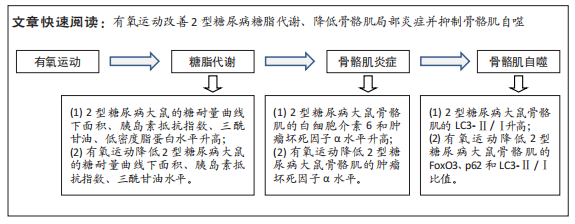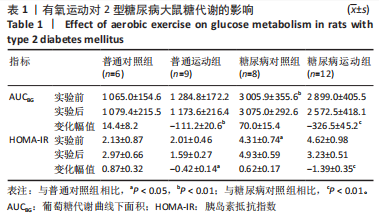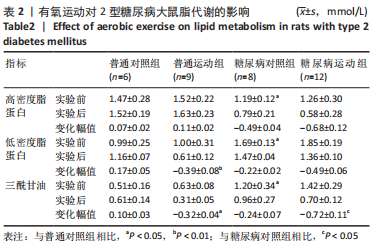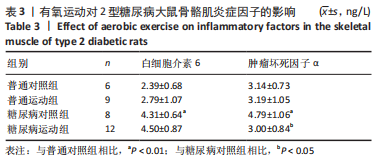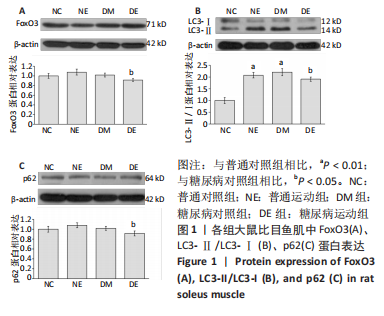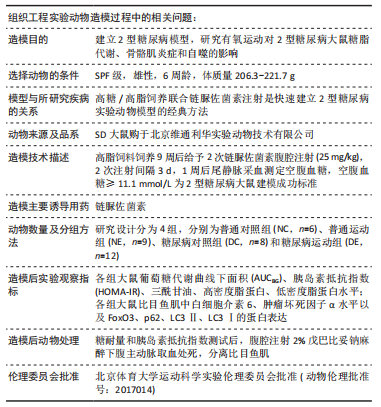[1] HARDING JL, PAVKOV ME, MAGLIANO DJ, et al. Global trends in diabetes complications: a review of current evidence. Diabetologia. 2019;62(1):3-16.
[2] HE F, CHEN W, XU W, et al. Safety and efficacy of liraglutide on reducing visceral and ectopic fat in adults with or without type 2 diabetes mellitus: A systematic review and meta-analysis. Diabetes Obes Metab. 2023;25(3): 664-674.
[3] AKBARI M, HASSAN-ZADEH V. IL-6 signalling pathways and the development of type 2 diabetes. Inflammopharmacology. 2018;26(3):685-698.
[4] O’NEILL BT, BHARDWAJ G, PENNIMAN CM, et al. FoxO Transcription Factors Are Critical Regulators of Diabetes-Related Muscle Atrophy. Diabetes. 2019; 68(3):556-570.
[5] PENNIMAN CM, BHARDWAJ G, NOWERS CJ, et al. Loss of FoxOs in muscle increases strength and mitochondrial function during aging. J Cachexia Sarcopenia Muscle. 2023;14(1):243-259.
[6] MARCHELEK-MYSLIWIEC M, NALEWAJSKA M, TUROŃ-SKRZYPIŃSKA A, et al. The Role of Forkhead Box O in Pathogenesis and Therapy of Diabetes Mellitus. Int J Mol Sci. 2022;23(19):11611.
[7] 王继,杨中亚,张龙,等.AMPK/PGC-1α在有氧运动改善2型糖尿病大鼠骨骼肌萎缩中的作用[J].中国组织工程研究,2020,24(20):3180-3185.
[8] 王继,张敏,杨中亚,等.体力活动干预2型糖尿病肌少症的研究现状[J].中国组织工程研究,2023,27(8):1272-1277.
[9] 中华医学会糖尿病学分会.中国2型糖尿病防治指南(2020年版) [J].中华糖尿病杂志,2021,13(4):315-409.
[10] YANG Z, SCOTT CA, MAO C, et al. Resistance exercise versus aerobic exercise for type 2 diabetes: a systematic review and meta-analysis. Sports Med. 2014;44(4):487-499.
[11] MARTIN IK, KATZ A, WAHREN J. Splanchnic and muscle metabolism during exercise in NIDDM patients. Am J Physiol. 1995;269(3 Pt 1):E583-E590.
[12] GUAN DY, SUN HW, WANG JT, et al. Rosiglitazone promotes glucose metabolism of GIFT tilapia based on the PI3K/Akt signaling pathway. Physiol Rep. 2021;9(5):e14765.
[13] ZHANG Y, LIU Y, LIU X, et al. Exercise and Metformin Intervention Prevents Lipotoxicity-Induced Hepatocyte Apoptosis by Alleviating Oxidative and ER Stress and Activating the AMPK/Nrf2/HO-1 Signaling Pathway in db/db Mice. Oxid Med Cell Longev. 2022;2022:2297268.
[14] WANG G. Aerobic exercise ameliorates myocardial ischemia/reperfusion injury and thrombosis of diabetic rats via activation of AMPK/Sirt1/PGC-1α pathway. Gen Physiol Biophys. 2022;41(4):319-328.
[15] 李颖,林文弢,翁锡全.不同运动强度干预2型糖尿病模型大鼠的内脂素及糖代谢变化[J].中国组织工程研究,2020,24(26):4196-4200.
[16] PIMENTEL JL, VANDER WYST KB, SOLTERO EG, et al. Organ fat in Latino youth at risk for type 2 diabetes. Pediatr Diabetes. 2022;23(3):286-290.
[17] HIGGINS S, ZEMEL BS, KHOURY PR, et al. Visceral fat and arterial stiffness in youth with healthy weight, obesity, and type 2 diabetes. Pediatr Obes. 2022;17(4):e12865.
[18] AHMED B, SULTANA R, GREENE MW. Adipose tissue and insulin resistance in obese. Biomed Pharmacother. 2021;137:111315.
[19] CAO C, SU M. Effects of berberine on glucose-lipid metabolism, inflammatory factors and insulin resistance in patients with metabolic syndrome. Exp Ther Med. 2019;17(4):3009-3014.
[20] SHAKIL-UR-REHMAN S, KARIMI H, GILLANI SA, et al. Response to a Supervised Structured Aerobic Exercise Training Program in Patients with Type 2 Diabetes Mellitus - Does Gender Make a Difference? A Randomized Controlled Clinical Trial. J Natl Med Assoc. 2018;110(5):431-439.
[21] XING H, LU J, YOONG SQ, et al. Effect of Aerobic and Resistant Exercise Intervention on Inflammaging of Type 2 Diabetes Mellitus in Middle-Aged and Older Adults: A Systematic Review and Meta-Analysis. J Am Med Dir Assoc. 2022;23(5):823-830.e13.
[22] NEMATOLLAHI S, PISHDAD GR, ZAKERKISH M, et al. The effect of berberine and fenugreek seed co-supplementation on inflammatory factor, lipid and glycemic profile in patients with type 2 diabetes mellitus: a double-blind controlled randomized clinical trial. Diabetol Metab Syndr. 2022;14(1):120.
[23] YANG K, ZHANG S, GENG Y, et al. Anti-Inflammatory Properties In Vitro and Hypoglycaemic Effects of Phenolics from Cultivated Fruit Body of Phellinus baumii in Type 2 Diabetic Mice. Molecules. 2021;26(8):2285.
[24] COBBOLD C. Type 2 diabetes mellitus risk and exercise: is resistin involved? J Sports Med Phys Fitness. 2019;59(2):290-297.
[25] MELO LC, DATIVO-MEDEIROS J, MENEZES-SILVA CE, et al. Physical Exercise on Inflammatory Markers in Type 2 Diabetes Patients: A Systematic Review of Randomized Controlled Trials. Oxid Med Cell Longev. 2017;2017:8523728.
[26] HEJAZI K, MOHAMMAD RAHIMI GR, ROSENKRANZ SK. Effects of Exercise Training on Inflammatory and Cardiometabolic Risk Biomarkers in Patients With Type 2 Diabetes Mellitus: A Systematic Review and Meta-Analysis of Randomized Controlled Trials. Biol Res Nurs. 2022:10998004221132841. doi: 10.1177/10998004221132841.
[27] PILLON NJ, SMITH JAB, ALM PS, et al. Distinctive exercise-induced inflammatory response and exerkine induction in skeletal muscle of people with type 2 diabetes. Sci Adv. 2022;8(36):eabo3192.
[28] YADAV A, SINGH A, PHOGAT J, et al. Magnoflorine prevent the skeletal muscle atrophy via Akt/mTOR/FoxO signal pathway and increase slow-MyHC production in streptozotocin-induced diabetic rats. J Ethnopharmacol. 2021;267:113510.
[29] ABD EL-KADER S, GARI A, SALAH EL-DEN A. Impact of moderate versus mild aerobic exercise training on inflammatory cytokines in obese type 2 diabetic patients: a randomized clinical trial. Afr Health Sci. 2013;13(4):857-863.
[30] CHOI S, JEONG HJ, KIM H, et al. Skeletal muscle-specific Prmt1 deletion causes muscle atrophy via deregulation of the PRMT6-FOXO3 axis. Autophagy. 2019;15(6):1069-1081.
[31] KIM KW, BAEK MO, CHOI JY, et al. Analysis of the Molecular Signaling Signatures of Muscle Protein Wasting Between the Intercostal Muscles and the Gastrocnemius Muscles in db/db Mice. Int J Mol Sci. 2019;20(23):6062.
[32] ROCCHI A, HE C. Regulation of Exercise-Induced Autophagy in Skeletal Muscle. Curr Pathobiol Rep. 2017;5(2):177-186.
[33] SANCHEZ AM, CANDAU RB, BERNARDI H. FoxO transcription factors: their roles in the maintenance of skeletal muscle homeostasis. Cell Mol Life Sci. 2014;71(9):1657-1671.
[34] DESHMUKH AS. Insulin-stimulated glucose uptake in healthy and insulin-resistant skeletal muscle. Horm Mol Biol Clin Investig. 2016;26(1):13-24.
[35] KITADA M, KOYA D. Autophagy in metabolic disease and ageing. Nat Rev Endocrinol. 2021;17(11):647-661.
[36] CAI Y, ZHAN H, WENG W, et al. Niclosamide ethanolamine ameliorates diabetes-related muscle wasting by inhibiting autophagy. Skelet Muscle. 2021;11(1):15.
[37] LEE Y, KIM JH, HONG Y, et al. Prophylactic effects of swimming exercise on autophagy-induced muscle atrophy in diabetic rats. Lab Anim Res. 2012; 28(3):171-179.
[38] YANG L, LIN H, LIN W, et al. Exercise Ameliorates Insulin Resistance of Type 2 Diabetes through Motivating Short-Chain Fatty Acid-Mediated Skeletal Muscle Cell Autophagy. Biology (Basel). 2020;9(8):203.
|
